AIDS-Related Lymphoma Treatment (PDQ®): Treatment - Patient Information [NCI]
General Information About AIDS-Related Lymphoma
AIDS-related lymphoma is a disease in which malignant (cancer) cells form in the lymph system of patients who have acquired immunodeficiency syndrome (AIDS).
AIDS is caused by the human immunodeficiency virus (HIV), which attacks and weakens the body's immune system. A weakened immune system is unable to fight infection and disease. People with HIV disease have an increased risk of infection and lymphoma or other types of cancer. A person with HIV and certain types of infection or cancer, such as lymphoma, is diagnosed as having AIDS. Sometimes, people are diagnosed with AIDS and AIDS-related lymphoma at the same time. For information about AIDS and its treatment, see the
AIDS-related lymphoma is a type of cancer that affects the lymph system. The lymph system is part of the immune system. It helps protect the body from infection and disease.
The lymph system is made up of the following:
- Lymph: Colorless, watery fluid that travels through the lymph vessels and carries T and B lymphocytes. Lymphocytes are a type of white blood cell.
- Lymph vessels: A network of thin tubes that collect lymph from different parts of the body and return it to the bloodstream.
- Lymph nodes: Small, bean-shaped structures that filter lymph and store white blood cells that help fight infection and disease. Lymph nodes are found along a network of lymph vessels throughout the body. Groups of lymph nodes are found in the neck, underarm, mediastinum, abdomen, pelvis, and groin.
- Spleen: An organ that makes lymphocytes, stores red blood cells and lymphocytes, filters the blood, and destroys old blood cells. The spleen is on the left side of the abdomen near the stomach.
- Thymus: An organ in which T lymphocytes mature and multiply. The thymus is in the chest behind the breastbone.
- Tonsils: Two small masses of lymph tissue at the back of the throat. There is one tonsil on each side of the throat.
- Bone marrow: The soft, spongy tissue in the center of certain bones, such as the hip bone and breastbone. White blood cells, red blood cells, and platelets are made in the bone marrow.
Lymph tissue is also found in other parts of the body such as the brain, stomach, thyroid gland, and skin.
Sometimes AIDS-related lymphoma occurs outside the lymph nodes in the bone marrow, liver, meninges (thin membranes that cover the brain) and gastrointestinal tract. Less often, it may occur in the anus, heart, bile duct, gingiva, and muscles.

The lymph system is part of the body's immune system and is made up of tissues and organs that help protect the body from infection and disease. These include the tonsils, adenoids (not shown), thymus, spleen, bone marrow, lymph vessels, and lymph nodes. Lymph tissue is also found in many other parts of the body, including the small intestine.
There are many different types of lymphoma.
Lymphomas are divided into two general types:
- Hodgkin lymphoma.
- Non-Hodgkin lymphoma.
Both non-Hodgkin lymphoma and Hodgkin lymphoma may occur in patients with AIDS, but non-Hodgkin lymphoma is more common. When a person with AIDS has non-Hodgkin lymphoma, it is called AIDS-related lymphoma. When AIDS-related lymphoma occurs in the central nervous system (CNS), it is called AIDS-related primary CNS lymphoma.
Non-Hodgkin lymphomas are grouped by the way their cells look under a microscope. They may be indolent (slow-growing) or aggressive (fast-growing). AIDS-related lymphomas are aggressive. There are two main types of AIDS-related non-Hodgkin lymphoma:
- Diffuse large B-cell lymphoma (including B-cell immunoblastic lymphoma).
- Burkitt or Burkitt-like lymphoma.
For more information about lymphoma or AIDS-related cancers, see the following:
- Adult Non-Hodgkin Lymphoma Treatment
- Childhood Non-Hodgkin Lymphoma Treatment
- Primary CNS Lymphoma Treatment
- Kaposi Sarcoma Treatment
Signs of AIDS-related lymphoma include weight loss, fever, and drenching night sweats.
These and other signs and symptoms may be caused by AIDS-related lymphoma or by other conditions. Check with your doctor if you have any of the following:
- Weight loss or fever for no known reason.
- Drenching night sweats.
- Painless, swollen lymph nodes in the neck, chest, underarm, or groin.
- A feeling of fullness below the ribs.
Tests that examine the lymph system and other parts of the body are used to diagnose AIDS-related lymphoma.
The following tests and procedures may be used:
- Physical exam and health history: An exam of the body to check general signs of health, including checking for signs of disease, such as lumps or anything else that seems unusual. A history of the patient's health, including fever, drenching night sweats, and weight loss, health habits, and past illnesses and treatments will also be taken.
- Complete blood count (CBC): A procedure in which a sample of blood is drawn and checked for the following:
- The number of red blood cells, white blood cells, and platelets.
- The amount of hemoglobin (the protein that carries oxygen) in the red blood cells.
- The portion of the sample made up of red blood cells.
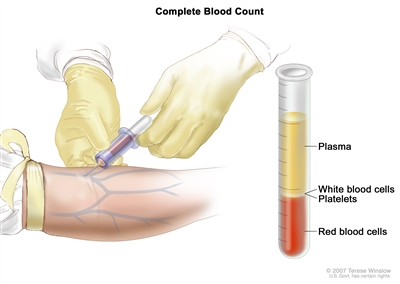
Complete blood count (CBC). Blood is collected by inserting a needle into a vein and allowing the blood to flow into a tube. The blood sample is sent to the laboratory and the red blood cells, white blood cells, and platelets are counted. The CBC is used to test for, diagnose, and monitor many different conditions. - Blood chemistry studies: A procedure in which a blood sample is checked to measure the amounts of certain substances released into the blood by organs and tissues in the body. An unusual (higher or lower than normal) amount of a substance can be a sign of disease.
- LDH test: A procedure in which a blood sample is checked to measure the amount of lactic dehydrogenase. An increased amount of LDH in the blood may be a sign of tissue damage, lymphoma, or other diseases.
- Hepatitis B and hepatitis C test: A procedure in which a sample of blood is checked to measure the amounts of hepatitis B virus-specific antigens and/or antibodies and the amounts of hepatitis C virus-specific antibodies. These antigens or antibodies are called markers. Different markers or combinations of markers are used to determine whether a patient has a hepatitis B or C infection, has had a prior infection or vaccination, or is susceptible to infection.
- HIV test: A test to measure the level of HIV antibodies in a sample of blood. Antibodies are made by the body when it is invaded by a foreign substance. A high level of HIV antibodies may mean the body has been infected with HIV.
- CT scan (CAT scan): A procedure that makes a series of detailed pictures of areas inside the body, such as the neck, chest, abdomen, pelvis, and lymph nodes, taken from different angles. The pictures are made by a computer linked to an x-ray machine. A dye may be injected into a vein or swallowed to help the organs or tissues show up more clearly. This procedure is also called computed tomography, computerized tomography, or computerized axial tomography.
- PET scan (positron emission tomography scan): A procedure to find malignant tumor cells in the body. A small amount of radioactive glucose (sugar) is injected into a vein. The PET scanner rotates around the body and makes a picture of where glucose is being used in the body. Malignant tumor cells show up brighter in the picture because they are more active and take up more glucose than normal cells do.
- Bone marrow aspiration and biopsy: The removal of bone marrow and a small piece of bone by inserting a hollow needle into the hipbone or breastbone. A pathologist views the bone marrow and bone under a microscope to look for signs of cancer.
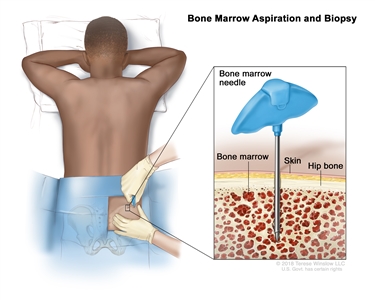
Bone marrow aspiration and biopsy. After a small area of skin is numbed, a long, hollow needle is inserted through the patient's skin and hip bone into the bone marrow. A sample of bone marrow and a small piece of bone are removed for examination under a microscope. - Lymph node biopsy: The removal of all or part of a lymph node. A pathologist views the tissue under a microscope to look for cancer cells. One of the following types of biopsies may be done:
- Excisional biopsy: The removal of an entire lymph node.
- Incisional biopsy: The removal of part of a lymph node.
- Core biopsy: The removal of tissue from a lymph node using a wide needle.
Other areas of the body, such as the liver, lung, bone, bone marrow, and brain, may also have a sample of tissue removed and checked by a pathologist for signs of cancer.
If cancer is found, the following tests may be done to study the cancer cells:
- Immunohistochemistry: A laboratory test that uses antibodies to check for certain antigens (markers) in a sample of a patient's tissue. The antibodies are usually linked to an enzyme or a fluorescent dye. After the antibodies bind to a specific antigen in the tissue sample, the enzyme or dye is activated, and the antigen can then be seen under a microscope. This type of test is used to help diagnose cancer and to help tell one type of cancer from another type of cancer.
- Cytogenetic analysis: A laboratory test in which the chromosomes of cells in a sample of blood or bone marrow are counted and checked for any changes, such as broken, missing, rearranged, or extra chromosomes. Changes in certain chromosomes may be a sign of cancer. Cytogenetic analysis is used to help diagnose cancer, plan treatment, or find out how well treatment is working.
- FISH (fluorescence in situ hybridization): A laboratory test used to look at and count genes or chromosomes in cells and tissues. Pieces of DNA that contain fluorescent dyes are made in the laboratory and added to a sample of a patient's cells or tissues. When these dyed pieces of DNA attach to certain genes or areas of chromosomes in the sample, they light up when viewed under a fluorescent microscope. The FISH test is used to help diagnose cancer and help plan treatment.
- Immunophenotyping: A laboratory test that uses antibodies to identify cancer cells based on the types of antigens or markers on the surface of the cells. This test is used to help diagnose specific types of lymphoma.
Certain factors affect prognosis (chance of recovery) and treatment options.
The prognosis and treatment options depend on the following:
- The stage of the cancer.
- The age of the patient.
- The number of CD4 lymphocytes (a type of white blood cell) in the blood.
- The number of places in the body lymphoma is found outside the lymph system.
- Whether the patient has a history of intravenous (IV) drug use.
- The patient's ability to carry out regular daily activities.
Stages of AIDS-Related Lymphoma
After AIDS-related lymphoma has been diagnosed, tests are done to find out if cancer cells have spread within the lymph system or to other parts of the body.
The process used to find out if cancer cells have spread within the lymph system or to other parts of the body is called staging. The information gathered from the staging process determines the stage of the disease. It is important to know the stage in order to plan treatment, but AIDS-related lymphoma is usually advanced when it is diagnosed.
The following tests and procedures may be used to find out if the cancer has spread:
- MRI (magnetic resonance imaging) with gadolinium: A procedure that uses a magnet, radio waves, and a computer to make a series of detailed pictures of areas inside the body, such as the brain and spinal cord. A substance called gadolinium is injected into the patient through a vein. The gadolinium collects around the cancer cells so they show up brighter in the picture. This procedure is also called nuclear magnetic resonance imaging (NMRI).
- Lumbar puncture: A procedure used to collect cerebrospinal fluid (CSF) from the spinal column. This is done by placing a needle between two bones in the spine and into the CSF around the spinal cord and removing a sample of the fluid. The sample of CSF is checked under a microscope for signs that the cancer has spread to the brain and spinal cord. The sample may also be checked for Epstein-Barr virus. This procedure is also called an LP or spinal tap.
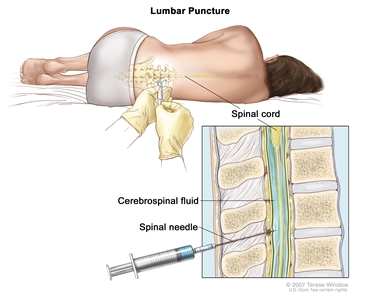
Lumbar puncture. A patient lies in a curled position on a table. After a small area on the lower back is numbed, a spinal needle (a long, thin needle) is inserted into the lower part of the spinal column to remove cerebrospinal fluid (CSF, shown in blue). The fluid may be sent to a laboratory for testing.
There are three ways that cancer spreads in the body.
Cancer can spread through tissue, the lymph system, and the blood:
- Tissue. The cancer spreads from where it began by growing into nearby areas.
- Lymph system. The cancer spreads from where it began by getting into the lymph system. The cancer travels through the lymph vessels to other parts of the body.
- Blood. The cancer spreads from where it began by getting into the blood. The cancer travels through the blood vessels to other parts of the body.
The following stages are used for AIDS-related lymphoma:
Stage I
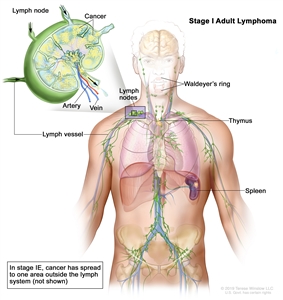
Stage I adult lymphoma. Cancer is found in one or more lymph nodes in a group of lymph nodes or, in rare cases, cancer is found in the Waldeyer's ring, thymus, or spleen. In stage IE (not shown), cancer has spread to one area outside the lymph system.
Stage I AIDS-related lymphoma is divided into stages I and IE.
- In stage I, cancer is found in one of the following places in the lymph system:
- One or more lymph nodes in a group of lymph nodes.
- Waldeyer's ring.
- Thymus.
- Spleen.
- In stage IE, cancer is found in one area outside the lymph system.
Stage II
Stage II AIDS-related lymphoma is divided into stages II and IIE.
- In stage II, cancer is found in two or more groups of lymph nodes that are either above the diaphragm or below the diaphragm.
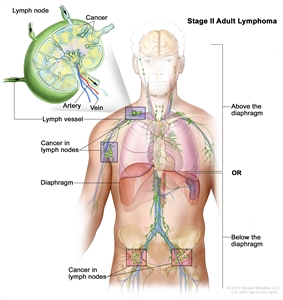
Stage II adult lymphoma. Cancer is found in two or more groups of lymph nodes that are either above the diaphragm or below the diaphragm. - In stage IIE, cancer has spread from a group of lymph nodes to a nearby area that is outside the lymph system. Cancer may have spread to other lymph node groups on the same side of the diaphragm.
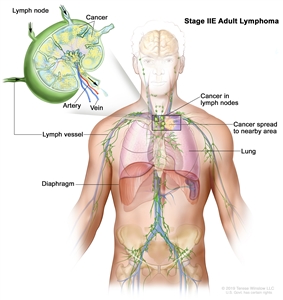
Stage IIE adult lymphoma. Cancer has spread from a group of lymph nodes to a nearby area that is outside the lymph system. Cancer may have spread to other lymph node groups on the same side of the diaphragm.
In stage II, the term bulky disease refers to a larger tumor mass. The size of the tumor mass that is referred to as bulky disease varies based on the type of lymphoma.
Stage III
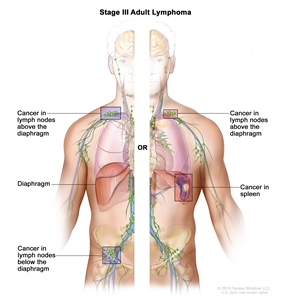
Stage III adult lymphoma. Cancer is found in groups of lymph nodes both above and below the diaphragm; or in a group of lymph nodes above the diaphragm and in the spleen.
In stage III AIDS-related lymphoma, cancer is found:
- in groups of lymph nodes both above and below the diaphragm; or
- in lymph nodes above the diaphragm and in the spleen.
Stage IV
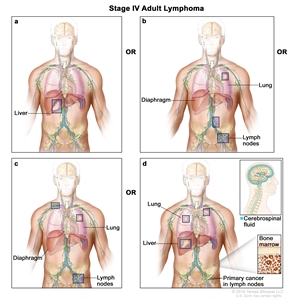
Stage IV adult lymphoma. Cancer (a) has spread throughout one or more organs outside the lymph system; or (b) is found in two or more groups of lymph nodes that are either above the diaphragm or below the diaphragm and in one organ that is outside the lymph system and not near the affected lymph nodes; or (c) is found in groups of lymph nodes above the diaphragm and below the diaphragm and in any organ that is outside the lymph system; or (d) is found in the liver, bone marrow, more than one place in the lung, or cerebrospinal fluid (CSF). The cancer has not spread directly into the liver, bone marrow, lung, or CSF from nearby lymph nodes.
In stage IV AIDS-related lymphoma, cancer:
- has spread throughout one or more organs outside the lymph system; or
- is found in two or more groups of lymph nodes that are either above the diaphragm or below the diaphragm and in one organ that is outside the lymph system and not near the affected lymph nodes; or
- is found in groups of lymph nodes both above and below the diaphragm and in any organ that is outside the lymph system; or
- is found in the liver, bone marrow, more than one place in the lung, or cerebrospinal fluid (CSF). The cancer has not spread directly into the liver, bone marrow, lung, or CSF from nearby lymph nodes.
Patients who are infected with the Epstein-Barr virus or whose AIDS-related lymphoma affects the bone marrow have an increased risk of the cancer spreading to the central nervous system (CNS).
For treatment, AIDS-related lymphomas are grouped based on where they started in the body, as follows:
Peripheral/systemic lymphoma
Lymphoma that starts in the lymph system or elsewhere in the body, other than the brain, is called peripheral/systemic lymphoma. It may spread throughout the body, including to the brain or bone marrow. It is often diagnosed in an advanced stage.
Primary CNS lymphoma
Primary CNS lymphoma starts in the central nervous system (brain and spinal cord). It is linked to the Epstein-Barr virus. Lymphoma that starts somewhere else in the body and spreads to the central nervous system is not primary CNS lymphoma.
Treatment Option Overview
There are different types of treatment for patients with AIDS-related lymphoma.
Different types of treatment are available for patients with AIDS-related lymphoma. Some treatments are standard (the currently used treatment), and some are being tested in clinical trials. A treatment clinical trial is a research study meant to help improve current treatments or obtain information on new treatments for patients with cancer. When clinical trials show that a new treatment is better than the standard treatment, the new treatment may become the standard treatment. Patients may want to think about taking part in a clinical trial. Some clinical trials are open only to patients who have not started treatment.
Treatment of AIDS-related lymphoma combines treatment of the lymphoma with treatment for AIDS.
Patients with AIDS have weakened immune systems and treatment can cause the immune system to become even weaker. For this reason, treating patients who have AIDS-related lymphoma is difficult and some patients may be treated with lower doses of drugs than lymphoma patients who do not have AIDS.
Highly active antiretroviral therapy (HAART) is used to lessen the damage to the immune system caused by HIV. Treatment with HAART may allow some patients with AIDS-related lymphoma to safely receive anticancer drugs in standard or higher doses. In these patients, treatment may work as well as it does in lymphoma patients who do not have AIDS. Medicine to prevent and treat infections, which can be serious, is also used.
For more information about AIDS and its treatment, see the
The following types of treatment are used:
Chemotherapy
Chemotherapy is a cancer treatment that uses drugs to stop the growth of cancer cells, either by killing the cells or by stopping them from dividing. When chemotherapy is taken by mouth or injected into a vein or muscle, the drugs enter the bloodstream and can reach cancer cells throughout the body (systemic chemotherapy). When chemotherapy is placed directly into the cerebrospinal fluid (intrathecal chemotherapy), an organ, or a body cavity such as the abdomen, the drugs mainly affect cancer cells in those areas (regional chemotherapy). Combination chemotherapy is treatment using more than one anticancer drug.
Intrathecal chemotherapy may be used in patients who are more likely to have lymphoma in the central nervous system (CNS).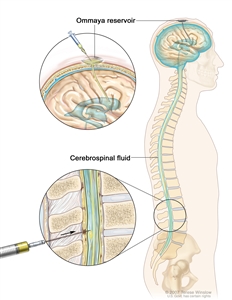
Intrathecal chemotherapy. Anticancer drugs are injected into the intrathecal space, which is the space that holds the cerebrospinal fluid (CSF, shown in blue). There are two different ways to do this. One way, shown in the top part of the figure, is to inject the drugs into an Ommaya reservoir (a dome-shaped container that is placed under the scalp during surgery; it holds the drugs as they flow through a small tube into the brain). The other way, shown in the bottom part of the figure, is to inject the drugs directly into the CSF in the lower part of the spinal column, after a small area on the lower back is numbed.
Chemotherapy is used in the treatment of AIDS-related peripheral/systemic lymphoma. It is not yet known whether it is best to give HAART at the same time as chemotherapy or after chemotherapy ends.
Colony-stimulating factors are sometimes given together with chemotherapy. This helps lessen the side effects chemotherapy may have on the bone marrow.
Radiation therapy
Radiation therapy is a cancer treatment that uses high-energy x-rays or other types of radiation to kill cancer cells or keep them from growing. External radiation therapy uses a machine outside the body to send radiation toward the area of the body with cancer.
High-dose chemotherapy with stem cell transplant
High doses of chemotherapy are given to kill cancer cells. Healthy cells, including blood -forming cells, are also destroyed by the cancer treatment. Stem cell transplant is a treatment to replace the blood-forming cells. Stem cells (immature blood cells) are removed from the blood or bone marrow of the patient and are frozen and stored. After the patient completes chemotherapy, the stored stem cells are thawed and given back to the patient through an infusion. These reinfused stem cells grow into (and restore) the body's blood cells.
Targeted therapy
Targeted therapy is a type of treatment that uses drugs or other substances to identify and attack specific cancer cells. Targeted therapies usually cause less harm to normal cells than chemotherapy or radiation therapy do.
- Monoclonal antibodies: Monoclonal antibodies are immune system proteins made in the laboratory to treat many diseases, including cancer. As a cancer treatment, these antibodies can attach to a specific target on cancer cells or other cells that may help cancer cells grow. The antibodies are able to then kill the cancer cells, block their growth, or keep them from spreading. Monoclonal antibodies are given by infusion. These may be used alone or to carry drugs, toxins, or radioactive material directly to cancer cells. Rituximab is used in the treatment of AIDS-related peripheral/systemic lymphoma.monoclonal antibodies: how monoclonal antibodies treat cancerHow do monoclonal antibodies work to treat cancer? This video shows how monoclonal antibodies, such as trastuzumab, pembrolizumab, and rituximab, block molecules cancer cells need to grow, flag cancer cells for destruction by the body's immune system, or deliver harmful substances to cancer cells.
New types of treatment are being tested in clinical trials.
Information about clinical trials is available from the
Treatment for AIDS-related lymphoma may cause side effects.
For information about side effects caused by treatment for cancer, visit our
Patients may want to think about taking part in a clinical trial.
For some patients, taking part in a clinical trial may be the best treatment choice. Clinical trials are part of the cancer research process. Clinical trials are done to find out if new cancer treatments are safe and effective or better than the standard treatment.
Many of today's standard treatments for cancer are based on earlier clinical trials. Patients who take part in a clinical trial may receive the standard treatment or be among the first to receive a new treatment.
Patients who take part in clinical trials also help improve the way cancer will be treated in the future. Even when clinical trials do not lead to effective new treatments, they often answer important questions and help move research forward.
Patients can enter clinical trials before, during, or after starting their cancer treatment.
Some clinical trials only include patients who have not yet received treatment. Other trials test treatments for patients whose cancer has not gotten better. There are also clinical trials that test new ways to stop cancer from recurring (coming back) or reduce the side effects of cancer treatment.
Clinical trials are taking place in many parts of the country. Information about clinical trials supported by NCI can be found on NCI's
Follow-up tests may be needed.
As you go through treatment, you will have follow-up tests or check-ups. Some tests that were done to diagnose or stage the cancer may be repeated to see how well the treatment is working. Decisions about whether to continue, change, or stop treatment may be based on the results of these tests.
Some of the tests will continue to be done from time to time after treatment has ended. The results of these tests can show if your condition has changed or if the cancer has recurred (come back).
Treatment of AIDS-Related Peripheral / Systemic Lymphoma
For information about the treatments listed below, see the Treatment Option Overview section.
Treatment of AIDS-related peripheral/systemic lymphoma may include the following:
- Combination chemotherapy with or without targeted therapy.
- High-dose chemotherapy and stem cell transplant, for lymphoma that has not responded to treatment or has come back.
- Intrathecal chemotherapy for lymphoma that is likely to spread to the central nervous system (CNS).
Use our
Treatment of AIDS-Related Primary Central Nervous System Lymphoma
For information about the treatments listed below, see the Treatment Option Overview section.
Treatment of AIDS-related primary central nervous system lymphoma may include the following:
- External radiation therapy.
Use our
To Learn More About AIDS-Related Lymphoma
For more information from the National Cancer Institute about AIDS-related lymphoma, see the following:
-
Stem Cell Transplants in Cancer TreatmentStem Cell Transplants in Cancer Treatment -
Targeted Therapy to Treat CancerTargeted Therapy to Treat Cancer
For general cancer information and other resources from the National Cancer Institute, visit:
-
About CancerAbout Cancer -
StagingStaging -
Chemotherapy and You: Support for People With CancerChemotherapy and You: Support for People With Cancer -
Radiation Therapy and You: Support for People With CancerRadiation Therapy and You: Support for People With Cancer -
Coping with CancerCoping with Cancer -
Questions to Ask Your Doctor about CancerQuestions to Ask Your Doctor about Cancer -
For Survivors and CaregiversFor Survivors and Caregivers
About This PDQ Summary
About PDQ
Physician Data Query (PDQ) is the National Cancer Institute's (NCI's) comprehensive cancer information database. The PDQ database contains summaries of the latest published information on cancer prevention, detection, genetics, treatment, supportive care, and complementary and alternative medicine. Most summaries come in two versions. The health professional versions have detailed information written in technical language. The patient versions are written in easy-to-understand, nontechnical language. Both versions have cancer information that is accurate and up to date and most versions are also available in
PDQ is a service of the NCI. The NCI is part of the National Institutes of Health (NIH). NIH is the federal government's center of biomedical research. The PDQ summaries are based on an independent review of the medical literature. They are not policy statements of the NCI or the NIH.
Purpose of This Summary
This PDQ cancer information summary has current information about the treatment of AIDS-related lymphoma. It is meant to inform and help patients, families, and caregivers. It does not give formal guidelines or recommendations for making decisions about health care.
Reviewers and Updates
Editorial Boards write the PDQ cancer information summaries and keep them up to date. These Boards are made up of experts in cancer treatment and other specialties related to cancer. The summaries are reviewed regularly and changes are made when there is new information. The date on each summary ("Updated") is the date of the most recent change.
The information in this patient summary was taken from the health professional version, which is reviewed regularly and updated as needed, by the
Clinical Trial Information
A clinical trial is a study to answer a scientific question, such as whether one treatment is better than another. Trials are based on past studies and what has been learned in the laboratory. Each trial answers certain scientific questions in order to find new and better ways to help cancer patients. During treatment clinical trials, information is collected about the effects of a new treatment and how well it works. If a clinical trial shows that a new treatment is better than one currently being used, the new treatment may become "standard." Patients may want to think about taking part in a clinical trial. Some clinical trials are open only to patients who have not started treatment.
Clinical trials can be found online at
Permission to Use This Summary
PDQ is a registered trademark. The content of PDQ documents can be used freely as text. It cannot be identified as an NCI PDQ cancer information summary unless the whole summary is shown and it is updated regularly. However, a user would be allowed to write a sentence such as "NCI's PDQ cancer information summary about breast cancer prevention states the risks in the following way: [include excerpt from the summary]."
The best way to cite this PDQ summary is:
PDQ® Adult Treatment Editorial Board. PDQ AIDS-Related Lymphoma Treatment. Bethesda, MD: National Cancer Institute. Updated <MM/DD/YYYY>. Available at:
Images in this summary are used with permission of the author(s), artist, and/or publisher for use in the PDQ summaries only. If you want to use an image from a PDQ summary and you are not using the whole summary, you must get permission from the owner. It cannot be given by the National Cancer Institute. Information about using the images in this summary, along with many other images related to cancer can be found in
Disclaimer
The information in these summaries should not be used to make decisions about insurance reimbursement. More information on insurance coverage is available on Cancer.gov on the
Contact Us
More information about contacting us or receiving help with the Cancer.gov website can be found on our
Last Revised: 2023-11-17
If you want to know more about cancer and how it is treated, or if you wish to know about clinical trials for your type of cancer, you can call the NCI's Cancer Information Service at 1-800-422-6237, toll free. A trained information specialist can talk with you and answer your questions.
This information does not replace the advice of a doctor. Ignite Healthwise, LLC, disclaims any warranty or liability for your use of this information. Your use of this information means that you agree to the
Healthwise, Healthwise for every health decision, and the Healthwise logo are trademarks of Ignite Healthwise, LLC.
Page Footer
I want to...
Audiences
Secure Member Sites
The Cigna Group Information
Disclaimer
Individual and family medical and dental insurance plans are insured by Cigna Health and Life Insurance Company (CHLIC), Cigna HealthCare of Arizona, Inc., Cigna HealthCare of Illinois, Inc., Cigna HealthCare of Georgia, Inc., Cigna HealthCare of North Carolina, Inc., Cigna HealthCare of South Carolina, Inc., and Cigna HealthCare of Texas, Inc. Group health insurance and health benefit plans are insured or administered by CHLIC, Connecticut General Life Insurance Company (CGLIC), or their affiliates (see
All insurance policies and group benefit plans contain exclusions and limitations. For availability, costs and complete details of coverage, contact a licensed agent or Cigna sales representative. This website is not intended for residents of New Mexico.